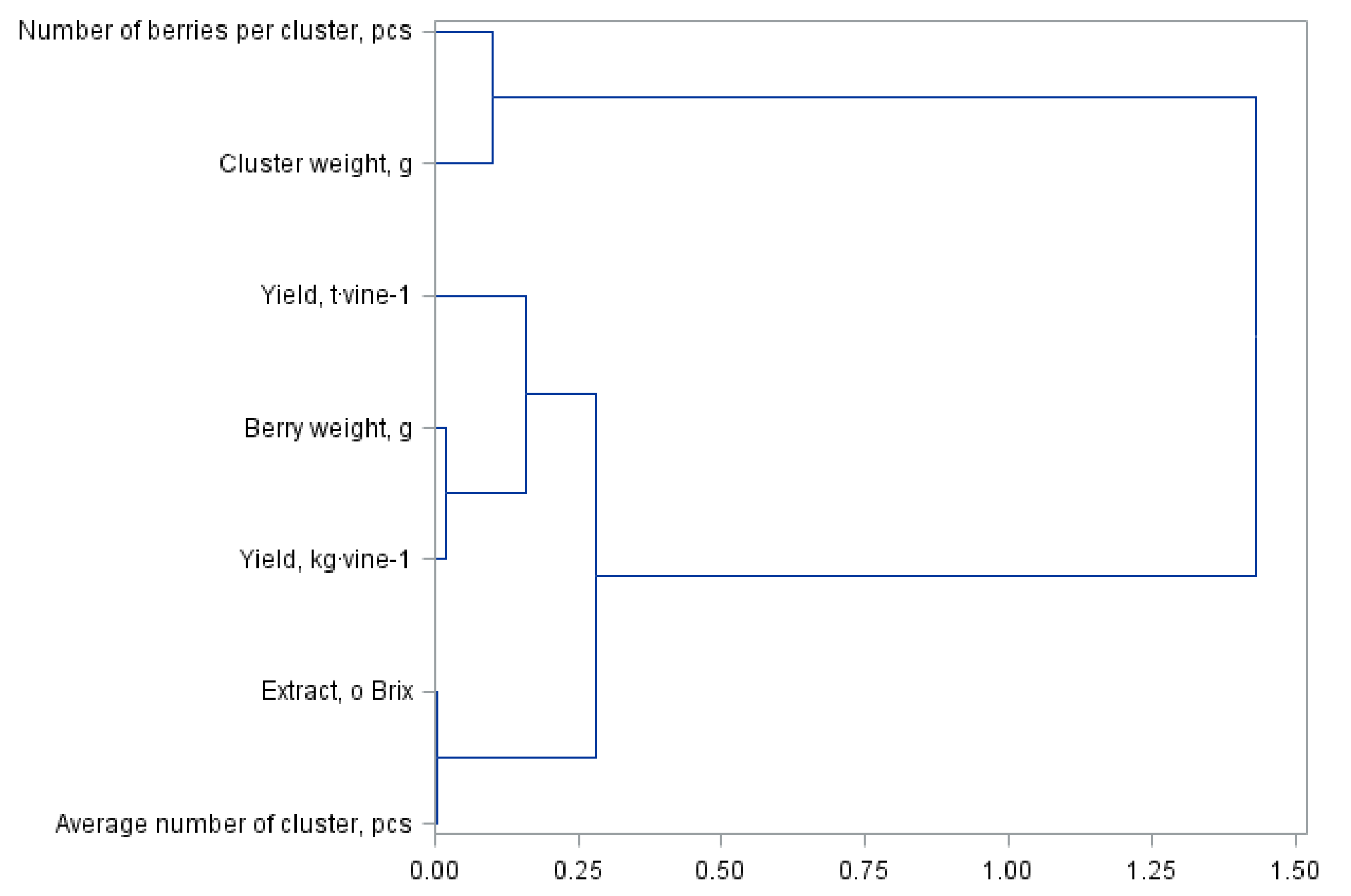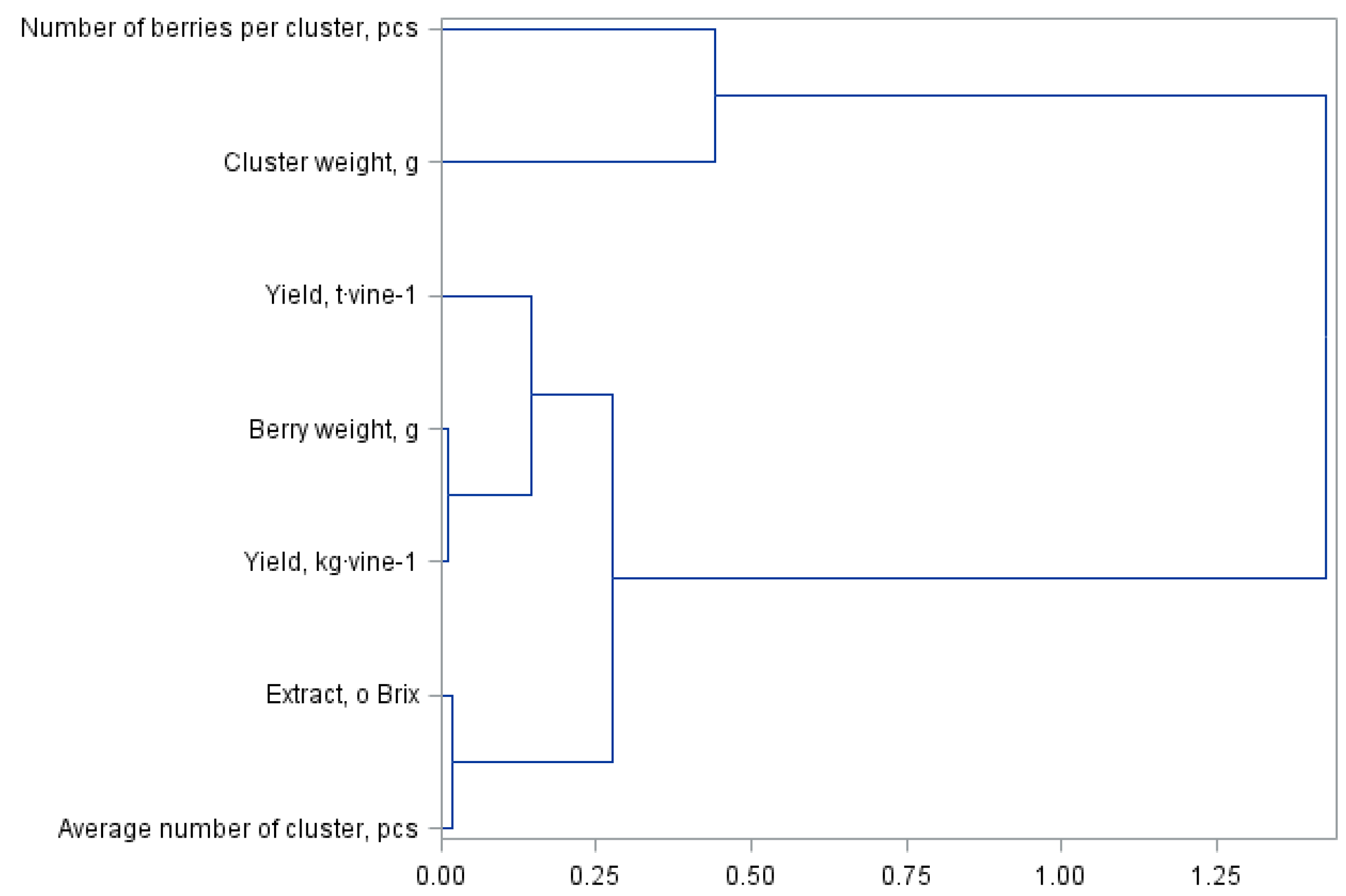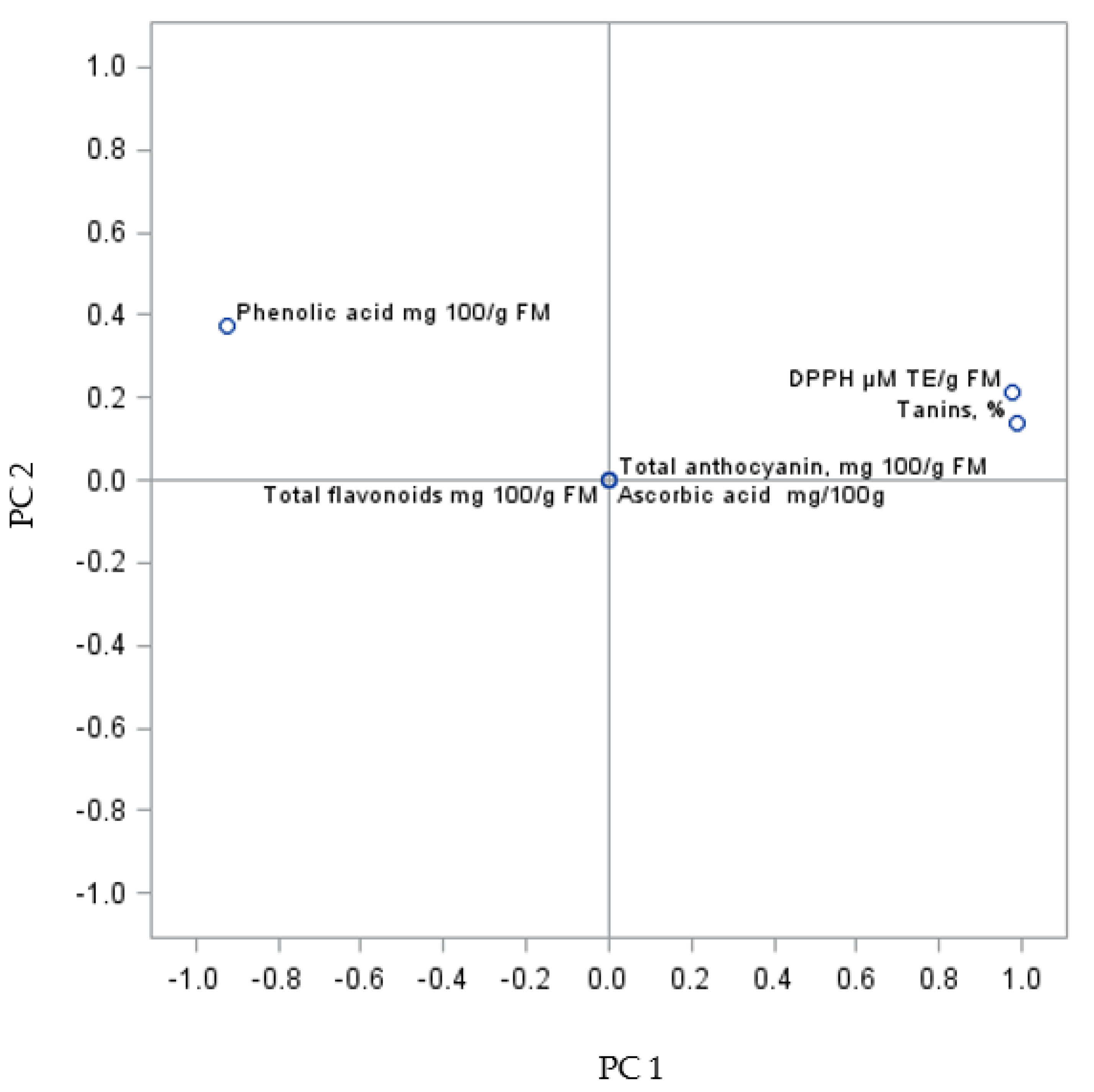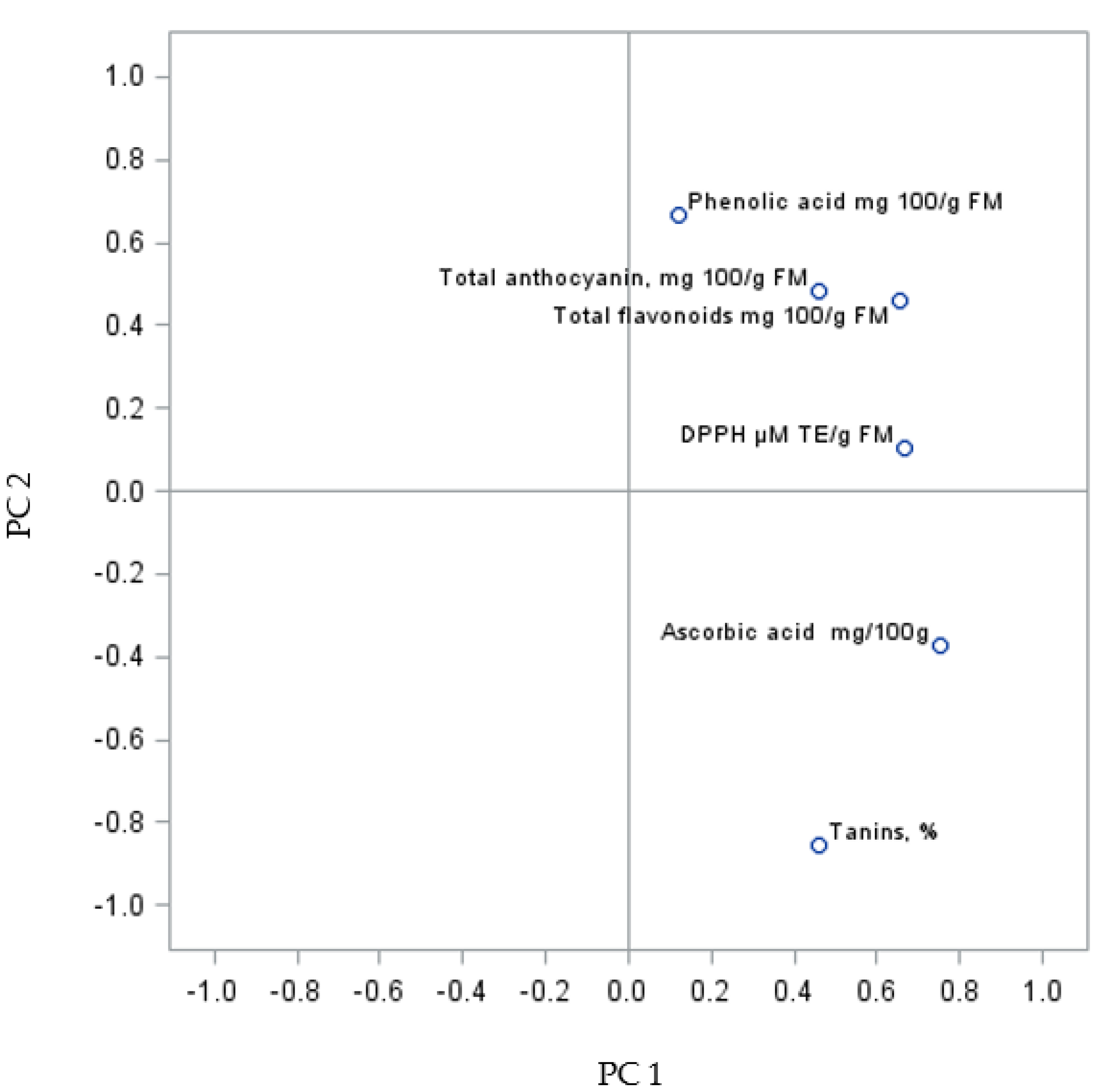Influence of Rootstock on Yield Quantity and Quality, Contents of Biologically Active Compounds and Antioxidant Activity in Regent Grapevine Fruit
Abstract
1. Introduction
2. Results and Discussion
2.1. Description of the Field Trial
2.2. Description of Biologically Active Compounds
2.3. Analysis of the Relationship between Yield Parameters and Biologically Active Compounds
3. Materials and Methods
Plant Materials
Physicochemical Analyses
Determination of L-Ascorbic Acid
Estimation of Anthocyanins by Means of Colorimetry
Determination of Antioxidant Activity (AA)
Estimation of Total Flavonoids
Tannin Estimation
4. Statistical Analysis
5. Conclusions
Author Contributions
Funding
Institutional Review Board Statement
Informed Consent Statement
Data Availability Statement
Conflicts of Interest
Sample Availability
References
- Censi, P.; Pisciotta, A.; Saiano, F.; Tuzzolino, N. Geochemical Behaviour of Rare Earths in Vitis Vinifera Grafted onto Different Rootstocks and Growing on Several Soils. Sci. Total Environ. 2014, 473–474, 597–608. [Google Scholar] [CrossRef] [PubMed]
- Garnett, C. Overview of the ICH E14 Guideline and Its Implementation within FDA. 80. Available online: https://www.fda.gov/media/104642/download (accessed on 21 March 2022).
- Ozden, M.; Vardin, H.; Simsek, M.; Karaaslan, M. Effects of Rootstocks and Irrigation Levels on Grape Quality of Vitis vinifera L. Cv. Shiraz. Afr. J. Biotechnol. 2010, 925, 3801–3807. [Google Scholar]
- Vršič, S.; Pulko, B.; Kocsis, L. Factors Influencing Grafting Success and Compatibility of Grape Rootstocks. Sci. Hortic. 2015, 181, 168–173. [Google Scholar] [CrossRef]
- Reynolds, A.G.; Wardle, D.A. Rootstocks Impact Vine Performance and Fruit Composition of Grapes in British Columbia. HortTechnology 2001, 11, 419. [Google Scholar] [CrossRef]
- Provost, C.; Campbell, A.; Dumont, F. Rootstocks Impact Yield, Fruit Composition, Nutrient Deficiencies, and Winter Survival of Hybrid Cultivars in Eastern Canada. Horticulturae 2021, 7, 237. [Google Scholar] [CrossRef]
- Winter Injury to Grapevines—PDF. Available online: https://shop.msu.edu/products/bulletin-e2930-pdf (accessed on 6 February 2022).
- Gambetta, G.A.; Manuck, C.M.; Drucker, S.T.; Shaghasi, T.; Fort, K.; Matthews, M.A.; Walker, M.A.; McElrone, A.J. The Relationship between Root Hydraulics and Scion Vigour across Vitis Rootstocks: What Role Do Root Aquaporins Play? J. Exp. Bot. 2012, 63, 6445–6455. [Google Scholar] [CrossRef]
- Kapłan, M.; Klimek, K.; Borowy, A.; Najda, A. Effect of Rootstock on Yield Quantity and Quality of Grapevine “Regent” in South-Eastern Poland. Acta Sci. Pol. Hortorum Cultus 2018, 17, 117–127. [Google Scholar] [CrossRef]
- Bates, T.; English-loeb, G.; Dunst, R.; Taft, T.; Lakso, A. The Interaction of Phylloxera Infection, Rootstock, and Irrigation on Young Concord Grapevine Growth. Vitis J. Grapevine Res. 2001, 40, 225–228. [Google Scholar]
- Harris, J.L. Effect of Rootstock on Vegetative Growth, Yield, and Fruit Composition of Norton Grapevines. Master’s thesis, University of Missouri, Columbia, MI, USA, 2013. [Google Scholar]
- Hoover, E.; Hemstad, P.; Larson, D.; MacKenzie, J.; Zambreno, K.; Propsom, F. Rootstock Influence on Scion Vigor, Hardiness, Yield, and Fruit Composition of St. Pepin Grape. Acta Hortic. 2004, 640, 201–206. [Google Scholar] [CrossRef]
- Miller, D.P.; Howell, G.S.; Striegler, R.K. Cane and Bud Hardiness of Selected Grapevine Rootstocks. Am. J. Enol. Vitic. 1988, 39, 55–59. [Google Scholar]
- Striegler, R.K.; Howell, G.S. The Influence of Rootstock on the Cold-Hardiness of Seyval Grapevines 1. Primary and Secondary Effects on Growth, Canopy Development, Yield, Fruit Quality and Cold Hardiness. Vitis 1991, 30, 1–10. [Google Scholar]
- Wolf, T.K.; Pool, R.M. Nitrogen Fertilization and Rootstock Effects on Wood Maturation and Dormant Bud Cold Hardiness of Cv. Chardonnay Grapevines. Am. J. Enol. Vitic. 1988, 39, 308–312. [Google Scholar]
- Terra, M.; Pires, E.; Pommer, C.; Botelho, R. Produtividade Da Cultivar de Uva de Mesa Niagara Rosada Sobre Diferentes Porta-Enxertos, Em Monte Alegre Do Sul-SP. Rev. Bras. Frutic. 2003, 25, 549–551. [Google Scholar] [CrossRef][Green Version]
- Keller, M.; Mills, L.; Harbertson, J. Rootstock Effects on Deficit-Irrigated Winegrapes in a Dry Climate: Vigor, Yield Formation, and Fruit Ripening. Am. J. Enol. Vitic. 2012, 63, 40–48. [Google Scholar] [CrossRef]
- Scions Influence Apparent Transpiration Efficiency of Vitis vinifera (cv. Shiraz) Rather than Rootstocks-FIS-Hochschule Geisenheim-Converis Standard Config. Available online: https://hs-gm.hessenfis.de/converis/portal/detail/Publication/4528590?lang=de_DE (accessed on 6 February 2022).
- Cookson, S.J.; Hevin, C.; Donnart, M.; Ollat, N. Grapevine Rootstock Effects on Scion Biomass Are Not Associated with Large Modifications of Primary Shoot Growth under Nonlimiting Conditions in the First Year of Growth. Funct. Plant Biol. 2012, 39, 650–660. [Google Scholar] [CrossRef]
- Somkuwar, R.G.; Jogaiah, S.; Sawant, S.D.; Taware, P.B.; Bondage, D.D.; Itroutwar, P. Rootstocks Influence the Growth, Biochemical Contents and Disease Incidence in Thompson Seedless Grapevines. Br. J. Appl. Sci. Technol. 2014, 4, 1030–1041. [Google Scholar] [CrossRef]
- Souza, C.; Mota, R. Cabernet Sauvignon Grapevine Grafted onto Rootstocks during the Autumn-Winter Season in Southeastern Brazilian. Sci. Agric. 2015, 72, 138. [Google Scholar] [CrossRef]
- Miele, A.; Rizzon, L.; Giovannini, E. Effect of Rootstock on Nutrient Content of “cabernet Sauvignon” Grapevine Tissues. Rev. Bras. De Frutic. 2009, 31, 1141–1149. [Google Scholar] [CrossRef]
- Kodur, S.; Tisdall, J.; Tang, C.; Walker, R. Uptake, Transport, Accumulation and Retranslocation of Potassium in Grapevine Rootstocks (Vitis). Vitis 2011, 50, 145–149. [Google Scholar]
- Serra, A.I.; Strever, P.A.; Myburgh, A. Deloire Review: The Interaction between Rootstocks and Cultivars (Vitis vinifera L.) to Enhance Drought Tolerance in Grapevine. Aust. J. Grape Wine Res. 2014, 20, 1–14. [Google Scholar] [CrossRef]
- de Herralde, F.; del Alsina, M.M.; Aranda, X.; Savé, R.; Biel, C. Effects of Rootstock and Irrigation Regime on Hydraulic Architecture of Vitis vinifera L. Cv. Tempranillo. OENO One 2006, 40, 133–139. [Google Scholar] [CrossRef]
- Rootstock Effects on Salt Tolerance of Irrigated Field-grown Grapevines (Vitis vinifera L. Cv. Sultana). 3. Fresh Fruit Composition and Dried Grape Quality-WALKER-2007-Australian Journal of Grape and Wine Research-Wiley Online Library. Available online: https://onlinelibrary.wiley.com/doi/abs/10.1111/j.1755-0238.2007.tb00243.x (accessed on 6 February 2022).
- Brown, D.S.; Jaspers, M.; Ridgway, H.; Barclay, C.; Jones, E.E. Susceptibility of Four Grapevine Rootstocks to Cylindrocladiella Parva. N. Z. Plant Prot. 2013, 66, 249–253. [Google Scholar] [CrossRef]
- Wallis, C.M.; Wallingford, A.K.; Chen, J. Grapevine Rootstock Effects on Scion Sap Phenolic Levels, Resistance to Xylella Fastidiosa Infection, and Progression of Pierce’s Disease. Front. Plant Sci. 2013, 4, 502. [Google Scholar] [CrossRef]
- Rosa, C.; Jimenez, J.F.; Margaria, P.; Rowhani, A. Symptomatology and Effects of Viruses Associated with Rugose Wood Complex on the Growth of Four Different Rootstocks. Am. J. Enol. Vitic. 2011, 62, 207–213. [Google Scholar] [CrossRef]
- Ferris, H.; Zheng, L.; Walker, M.A. Resistance of Grape Rootstocks to Plant-Parasitic Nematodes. J. Nematol. 2012, 44, 377–386. [Google Scholar] [PubMed]
- Marguerit, E.; Brendel, O.; Lebon, E.; Van Leeuwen, C.; Ollat, N. Rootstock Control of Scion Transpiration and Its Acclimation to Water Deficit Are Controlled by Different Genes. New Phytol. 2012, 194, 416–429. [Google Scholar] [CrossRef]
- Jin, Z.-X.; Sun, T.-Y.; Sun, H.; Yue, Q.-Y.; Yao, Y.-X. Modifications of ‘Summer Black’ Grape Berry Quality as Affected by the Different Rootstocks. Sci. Hortic. 2016, 210, 130–137. [Google Scholar] [CrossRef]
- Ibacache, A.; Albornoz, F.; Zurita-Silva, A. Yield Responses in Flame Seedless, Thompson Seedless and Red Globe Table Grape Cultivars Are Differentially Modified by Rootstocks under Semi Arid Conditions. Sci. Hortic. 2016, 204, 25–32. [Google Scholar] [CrossRef]
- Gris, E.F.; Mattivi, F.; Ferreira, E.A.; Vrhovsek, U.; Filho, D.W.; Pedrosa, R.C.; Bordignon-Luiz, M.T. Stilbenes and Tyrosol as Target Compounds in the Assessment of Antioxidant and Hypolipidemic Activity of Vitis vinifera Red Wines from Southern Brazil. J. Agric. Food Chem. 2011, 59, 7954–7961. [Google Scholar] [CrossRef]
- Espín, J.C.; García-Conesa, M.T.; Tomás-Barberán, F.A. Nutraceuticals: Facts and Fiction. Phytochemistry 2007, 68, 2986–3008. [Google Scholar] [CrossRef]
- Stintzing, F.C.; Carle, R. Functional Properties of Anthocyanins and Betalains in Plants, Food, and in Human Nutrition. Trends Food Sci. Technol. 2004, 15, 19–38. [Google Scholar] [CrossRef]
- Wang, X.-T.; Miao, Y.; Zhang, Y.; Li, Y.-C.; Wu, M.-H.; Yu, G. Polycyclic Aromatic Hydrocarbons (PAHs) in Urban Soils of the Megacity Shanghai: Occurrence, Source Apportionment and Potential Human Health Risk. Sci. Total Environ. 2013, 447, 80–89. [Google Scholar] [CrossRef] [PubMed]
- Fuleki, T.; Ricardo-da-Silva, J.M. Effects of Cultivar and Processing Method on the Contents of Catechins and Procyanidins in Grape Juice. J. Agric. Food Chem. 2003, 51, 640–646. [Google Scholar] [CrossRef] [PubMed]
- Manach, C.; Scalbert, A.; Morand, C.; Rémésy, C.; Jiménez, L. Polyphenols: Food Sources and Bioavailability. Am. J. Clin. Nutr. 2004, 79, 727–747. [Google Scholar] [CrossRef]
- Abe, L.T.; Mota, R.; Lajolo, F.M.; Genovese, M.I. Compostos Fenólicos e Capacidade Antioxidante de Cultivares de Uvas Vitis Labrusca L. e Vitis vinifera L. Food Sci. Technol. 2007, 27, 394–400. [Google Scholar] [CrossRef]
- Pozzan, M.S.V.; Braga, G.C.; Salibe, A.B. Anthocyanins, total phenols, tannins and ascorbic acid in cv. Bordô grape on different rootstocks. Rev. Ceres 2012, 59, 701–708. [Google Scholar] [CrossRef]
- Rockenbach, I.; Gonzaga, L.; Rizelio, V.; Gonçalves, A.E.; Genovese, M.; Fett, R. Phenolic Compounds and Antioxidant Activity of Seed and Skin Extracts of Red Grape (Vitis vinifera and Vitis labrusca) Pomace from Brazilian Winemaking. Food Res. Int. 2011, 44, 897–901. [Google Scholar] [CrossRef]
- De Silva, D.; Poliquin, S.; Zeng, R.; Zamudio-Ochoa, A.; Marrero, N.; Perez-Martinez, X.; Fontanesi, F.; Barrientos, A. The DEAD-Box Helicase Mss116 Plays Distinct Roles in Mitochondrial Ribogenesis and MRNA-Specific Translation. Nucleic Acids Res. 2017, 45, 6628–6643. [Google Scholar] [CrossRef]
- Silva, L.F.O.; Fdez-Ortiz de Vallejuelo, S.; Martinez-Arkarazo, I.; Castro, K.; Oliveira, M.L.S.; Sampaio, C.H.; de Brum, I.A.S.; de Leão, F.B.; Taffarel, S.R.; Madariaga, J.M. Study of Environmental Pollution and Mineralogical Characterization of Sediment Rivers from Brazilian Coal Mining Acid Drainage. Sci. Total Environ. 2013, 447, 169–178. [Google Scholar] [CrossRef]
- Lago-Vanzela, E.S.; Da-Silva, R.; Gomes, E.; García-Romero, E.; Hermosín-Gutiérrez, I. Phenolic Composition of the Edible Parts (Flesh and Skin) of Bordô Grape (Vitis labrusca) Using HPLC–DAD–ESI-MS/MS. J. Agric. Food Chem. 2011, 59, 13136–13146. [Google Scholar] [CrossRef]
- Barcia, M.T.; Pertuzatti, P.B.; Gómez-Alonso, S.; Godoy, H.T.; Hermosín-Gutiérrez, I. Phenolic Composition of Grape and Winemaking By-Products of Brazilian Hybrid Cultivars BRS Violeta and BRS Lorena. Food Chem. 2014, 159, 95–105. [Google Scholar] [CrossRef] [PubMed]
- Burin, V.M.; Ferreira-Lima, N.E.; Panceri, C.; Bordignon-Luiz, M. Bioactive Compounds and Antioxidant Activity of Vitis Vinifera and Vitis Labrusca Grapes: Evaluation of Different Extraction Methods. Microchem. J. 2014, 114, 155–163. [Google Scholar] [CrossRef]
- Koundouras, S.; Hatzidimitriou, E.; Karamolegkou, M.; Dimopoulou, E.; Kallithraka, S.; Tsialtas, J.; Zioziou, E.; Nikolaou, N.; Kotseridis, Y. Irrigation and Rootstock Effects on the Phenolic Concentration and Aroma Potential of Vitis vinifera L. Cv. Cabernet Sauvignon Grapes. J. Agric. Food Chem. 2009, 57, 7805–7813. [Google Scholar] [CrossRef] [PubMed]
- de Silva, D.D.; Groenewald, J.Z.; Crous, P.W.; Ades, P.K.; Nasruddin, A.; Mongkolporn, O.; Taylor, P.W.J. Identification, Prevalence and Pathogenicity of Colletotrichum Species Causing Anthracnose of Capsicum Annuum in Asia. IMA Fungus 2019, 10, 8. [Google Scholar] [CrossRef] [PubMed]
- Ochmian, I.; Mijowska, K. Wpływ Podkładek Na Jakość Owoców Winorośli Odmiany Regent The Influence of Rootstocks on Quality of Fruit Grapes Regent Cultivar. Bad. I Rozw. Młodych Nauk. W Polsce Nauk. Przyr. 2015, 1, 92–98. [Google Scholar]
- Schmid, J.; Manty, F.; Huber, L.; Porten, M.; Ruehl, E. Experience with Rootstock Varieties in Germany. In Proceedings of the 2005 Rootstocks Symposium–Grapevine Rootstocks: Current Use, Research, and Application, Osage Beach, MO, USA, 1 February 2005; pp. 14–24. [Google Scholar]
- Schreiner, R.P. Mycorrhizal Colonization of Grapevine Rootstocks under Field Conditions. Am. J. Enol. Vitic. 2003, 54, 143–149. [Google Scholar]
- Mota, R.; Souza, C.; Favero, A.; Silva, C.; Carmo, E.; Fonseca, A.; Regina, M. Produtividade e Composição Físico-Química de Bagas de Cultivares de Uva Em Distintos Porta-Enxertos. Pesqui. Agropecu. Bras. PAB 2009, 44, 576–582. [Google Scholar] [CrossRef]
- Ehrhardt, C.; Arapitsas, P.; Stefanini, M.; Flick, G.; Mattivi, F. Analysis of the Phenolic Composition of Fungus-Resistant Grape Varieties Cultivated in Italy and Germany Using UHPLC-MS/MS. J. Mass Spectrom. 2014, 49, 860–869. [Google Scholar] [CrossRef]
- Verdugo-Vásquez, N.; Gutiérrez-Gamboa, G.; Villalobos-Soublett, E.; Zurita-Silva, A. Effects of Rootstocks on Blade Nutritional Content of Two Minority Grapevine Varieties Cultivated under Hyper-Arid Conditions in Northern Chile. Agronomy 2021, 11, 327. [Google Scholar] [CrossRef]
- De Alvarenga, E.S. Characterization and Properties of Chitosan. In Biotechnology of Biopolymers; Elnashar, M., Ed.; InTech: Vienna, Austria, 2011; ISBN 978-953-307-179-4. [Google Scholar]
- Vedoato, B.; Neto, F.; Pimentel Junior, A.; Paiva, A.; Silva, M.; Moura, M.; Lima, G.; Tecchio, M. Production, Physicochemical Quality and Antioxidant Capacity of ‘Niagara Rosada’ Grape Grafted on Different Rootstocks. Biosci. J. 2020, 36. [Google Scholar] [CrossRef]
- Tecchio, M.; Moura, M.; Junqueira, T.; Pires, E.; Leonel, S. Influence of Rootstocks and Pruning Times on Yield and on Nutrient Content and Extraction in “Niagara Rosada” Grapevine. Embrapa Secretaria de Pesquisa e Desenvolvimento, Pesquisa Agropecuária Brasileira Pesqui. Agropecu. Bras. 2014, 49, 340–348. [Google Scholar] [CrossRef]
- Yang, J.; Martinson, T.E.; Liu, R.H. Phytochemical Profiles and Antioxidant Activities of Wine Grapes. Food Chem. 2009, 116, 332–339. [Google Scholar] [CrossRef]
- Anastasiadi, M.; Pratsinis, H.; Kletsas, D.; Skaltsounis, A.-L.; Haroutounian, S.A. Grape Stem Extracts: Polyphenolic Content and Assessment of Their in Vitro Antioxidant Properties. LWT Food Sci. Technol. 2012, 48, 316–322. [Google Scholar] [CrossRef]
- Bunea, C.-I.; Popescu, D.; Bunea, A.; Ardelean, M. Variation of Attack Degree of Downy Mildew (Plasmopara viticola) in Five Wine Grape Varieties, under Conventional and Organic Control Treatments. J. Food Agric. Environ. 2013, 11, 1166–1170. [Google Scholar]
- Mijowska, K.; Ochmian, I.; Oszmiański, J. Impact of Cluster Zone Leaf Removal on Grapes Cv. Regent Polyphenol Content by the UPLC-PDA/MS Method. Molecules 2016, 21, 1688. [Google Scholar] [CrossRef]
- Satisha, J.; Doshi, P.; Adsule, P.G. Influence of Rootstocks on Changing the Pattern of Phenolic Compounds in Thompson Seedless Grapes and Its Relationship to the Incidence of Powdery Mildew. Turk. J. Agric. For. 2008, 32, 1–9. [Google Scholar]
- Suriano, S.; Alba, V.; Di Gennaro, D.; Suriano, M.S.; Savino, M.; Tarricone, L. Genotype/Rootstocks Effect on the Expression of Anthocyanins and Flavans in Grapes and Wines of Greco Nero n. (Vitis vinifera L.). Sci. Hortic. 2016, 209, 309–315. [Google Scholar] [CrossRef]
- Muñoz, I.; Ruiz, A.; Marquina, M.; Barceló, A.; Albert, A.; Ariño, J. Functional Characterization of the Yeast Ppz1 Phosphatase Inhibitory Subunit Hal3: A MUTAGENESIS STUDY. J. Biol. Chem. 2004, 279, 42619–42627. [Google Scholar] [CrossRef]
- Rebello, L.P.G.; Lago-Vanzela, E.S.; Barcia, M.T.; Ramos, A.M.; Stringheta, P.C.; Da-Silva, R.; Castillo-Muñoz, N.; Gómez-Alonso, S.; Hermosín-Gutiérrez, I. Phenolic Composition of the Berry Parts of Hybrid Grape Cultivar BRS Violeta (BRS Rubea×IAC 1398-21) Using HPLC–DAD–ESI-MS/MS. Food Res. Int. 2013, 54, 354–366. [Google Scholar] [CrossRef]
- Mazza, G. Anthocyanins in Grapes and Grape Products. Crit. Rev. Food Sci. Nutr. 1995, 35, 341–371. [Google Scholar] [CrossRef]
- Wine, Biodiversity, Technology, and Antioxidants-MATTIVI-2002-Annals of the New York Academy of Sciences-Wiley Online Library. Available online: https://nyaspubs.onlinelibrary.wiley.com/doi/abs/10.1111/j.1749-6632.2002.tb02904.x (accessed on 7 February 2022).
- Munoz-Espada, A.C.; Wood, K.V.; Bordelon, B.; Watkins, B.A. Anthocyanin Quantification and Radical Scavenging Capacity of Concord, Norton, and Marechal Foch Grapes and Wines. J. Agric. Food Chem. 2004, 52, 6779–6786. [Google Scholar] [CrossRef] [PubMed]
- RYAN v. NUZZO, No. CV 06 5005836 S (Jun. 6, 2007), 2007 Ct. Sup. 8984|Conn. Super. Ct., Judgment, Law, Casemine.Com. Available online: https://www.casemine.com/judgement/us/59146e07add7b0493432e287 (accessed on 7 February 2022).
- Proceedings of the Annual New York Wine Industry Workshop; New York State Agricultural Experiment Station, Cornell University: New York, NY, USA, 1999.
- Xu, C.; Zhang, Y.; Cao, L.; Lu, J. Phenolic Compounds and Antioxidant Properties of Different Grape Cultivars Grown in China. Food Chem. 2010, 119, 1557–1565. [Google Scholar] [CrossRef]
- Nixdorf, S.L.; Hermosín-Gutiérrez, I. Brazilian Red Wines Made from the Hybrid Grape Cultivar Isabel: Phenolic Composition and Antioxidant Capacity. Anal. Chim. Acta 2010, 659, 208–215. [Google Scholar] [CrossRef] [PubMed]
- Polish Pharmacopoeia, IX; PTFarm: Warsaw, Poland, 2011.
- Polish Pharmacopoeia, X; PTFarm: Warsaw, Poland, 2014.
- European Pharmacopoeia, X, Ph. Eur.; Council of Europe: Strasbourg, France, 2008.




| Root Stock | Average Number of Cluster, pcs | Yield, kg∙vine−1 | Yield, t∙vine−1 | Cluster Weight, g | Number of Berries per Cluster, pcs | Berry Weight, g | Solid Content, Brix | Total Acidity, % |
|---|---|---|---|---|---|---|---|---|
| 101-14 | 19.2 ± 4.87 B | 2.1 ± 0.83 B | 9.9 ± 4.56 B | 101.4 ± 20.21 B | 78.8 ± 4.48 B | 1.4 ± 0.329 BC | 16.77 ± 0.72 B | 0.43 ± 0.010 D |
| 125 AA | 24.3 ± 5.09 A | 2.9 ± 0.46 A | 14.8 ± 2.53 A | 128.1 ± 9.64 A | 74.3 ± 31.12 B | 1.9 ± 0.343 A | 20.58 ± 0.17 A | 0.59 ± 0.026 A |
| 161-49 | 13.8 ± 7.45 D | 1.1 ± 0.51 C | 5.3 ± 2.52 C | 87.3 ± 13.85 C | 70.1 ± 13.12 B | 1.2 ± 0.238 BCD | 20.83 ± 0.09 A | 0.51 ± 0.006 B |
| 5 BB | 15.2 ± 10.77 CD | 1.5 ± 1.21 C | 7.6 ± 5.99 C | 87.0 ± 29.81 C | 55.1 ± 10.91 C | 1.5 ± 0.339 B | 20.27 ± 0.22 A | 0.52 ± 0.015 B |
| Own root | 20.8 ± 3.28 AB | 2.2 ± 0.22 B | 10.9 ± 1.11 B | 98.1 ± 5.24 B | 92.2 ± 10.83 A | 1.0 ± 0.114 D | 21.32 ± 0.26 A | 0.48 ± 0.052 C |
| SO4 | 22.9 ± 7.12 A | 2.4 ± 0.68 B | 12.1 ± 3.45 B | 103.6 ± 17.94 B | 88.1 ± 14.62 A | 1.3 ± 0.188 BCD | 19.71 ± 0.14 A | 0.61 ± 0.021 A |
| SORI | 18.4 ± 8.14 BC | 1.9 ± 0.99 BC | 9.6 ± 4.97 BC | 102.6 ± 20.64 B | 94.2 ± 13.14 A | 1.1 ± 0.267 CD | 20.58 ± 0.17 A | 0.53 ± 0.032 B |
| p-value | 0.0263 | <0.0001 | <0.0001 | 0.0003 | <0.0001 | <0.0001 | <0.0001 | <0.0001 |
| Rootstock | Ascorbic Acid mg 100 × g−1 | Phenolic Acid mg 100 × g−1 FM | Total Flavonoids mg 100 × g−1 FM | Total Anthocyanin, mg 100 × g−1 FM | Tannins, % | DPPH µM Te × g−1 FM |
|---|---|---|---|---|---|---|
| 101-14 | 28.3 ± 2.51 D | 0.13 ± 0.001 D | 0.08 ± 0.001 B | 338.9 ± 53.91 F | 0.21 ± 0.001 C | 70.7 ± 0.12 C |
| 125 AA | 34.6 ± 0.57 C | 0.18 ± 0.001 B | 0.11 ± 0.005 A | 529.0 ± 0.01 B | 0.17 ± 0.001 D | 81.3 ± 0.12 B |
| 161-49 | 28.0 ± 1.01 D | 0.15 ± 0.000 C | 0.07 ± 0.001 C | 396.3 ± 0.01 E | 0.21 ± 0.001 C | 60.7 ± 0.12 D |
| 5 BB | 45.7 ± 4.04 A | 0.18 ± 0.000 B | 0.08 ± 0.007 B | 456.9 ± 13.61 C | 0.30 ± 0.001 A | 56.4 ± 0.12 E |
| Own root | 37.0 ± 0.01 C | 0.17 ± 0.014 B | 0.08 ± 0.000 B | 713.5 ± 0.01 A | 0.20 ± 0.001 C | 78.1 ± 0.12 B |
| SO4 | 27.3 ± 1.53 D | 0.21 ± 0.032 A | 0.08 ± 0.001 B | 444.9 ± 0.01 D | 0.14 ± 0.001 E | 62.1 ± 0.12 D |
| SORI | 42.0 ± 2.64 B | 0.17 ± 0.000 B | 0.08 ± 0.001 B | 331.4 ± 58.81 F | 0.26 ± 0.001 B | 87.0 ± 0.12 A |
| p-value | <0.0001 | <0.0001 | <0.0001 | <0.0001 | <0.0001 | <0.0001 |
| Ascorbic Acid mg × 100 g–1 | Phenolic Acid mg × 100 g–1 FM | Total Flavonoids mg × 100 g–1 FM | Total Anthocyanin, mg 100 × g–1 FM | Tannins % | DPPH µM TE × g–1 FM | |
|---|---|---|---|---|---|---|
| Average number of cluster, pcs | −0.1655 | 0.3205 | 0.2548 | 0.2054 | −0.3303 | 0.2346 |
| Yield, kg∙vine–1 | −0.1316 | 0.3456 | 0.4285 | 0.2281 | −0.3416 | 0.3486 |
| Yield, t∙vine–1 | −0.1209 | 0.3557 | 0.4388 | 0.2338 | −0.3361 | 0.3487 |
| Cluster weight, g | −0.1908 | 0.1340 | 0.5386 | 0.1210 | −0.2719 | 0.4258 |
| Number of berries per cluster, pcs | −0.2420 | 0.0473 | 0.0014 | 0.1006 | −0.3455 | 0.5674 |
| Berry weight, g | 0.0001 | 0.1874 | 0.5752 | 0.0513 | −0.0597 | −0.0459 |
| Solid content, °Brix | 0.4078 | 0.4137 | 0.0413 | 0.5339 | 0.0819 | 0.1376 |
| Total acidity, % | 0.0039 | 0.7769 | 0.2897 | 0.0361 | −0.4866 | −0.0294 |
Publisher’s Note: MDPI stays neutral with regard to jurisdictional claims in published maps and institutional affiliations. |
© 2022 by the authors. Licensee MDPI, Basel, Switzerland. This article is an open access article distributed under the terms and conditions of the Creative Commons Attribution (CC BY) license (https://creativecommons.org/licenses/by/4.0/).
Share and Cite
Klimek, K.; Kapłan, M.; Najda, A. Influence of Rootstock on Yield Quantity and Quality, Contents of Biologically Active Compounds and Antioxidant Activity in Regent Grapevine Fruit. Molecules 2022, 27, 2065. https://doi.org/10.3390/molecules27072065
Klimek K, Kapłan M, Najda A. Influence of Rootstock on Yield Quantity and Quality, Contents of Biologically Active Compounds and Antioxidant Activity in Regent Grapevine Fruit. Molecules. 2022; 27(7):2065. https://doi.org/10.3390/molecules27072065
Chicago/Turabian StyleKlimek, Kamila, Magdalena Kapłan, and Agnieszka Najda. 2022. "Influence of Rootstock on Yield Quantity and Quality, Contents of Biologically Active Compounds and Antioxidant Activity in Regent Grapevine Fruit" Molecules 27, no. 7: 2065. https://doi.org/10.3390/molecules27072065
APA StyleKlimek, K., Kapłan, M., & Najda, A. (2022). Influence of Rootstock on Yield Quantity and Quality, Contents of Biologically Active Compounds and Antioxidant Activity in Regent Grapevine Fruit. Molecules, 27(7), 2065. https://doi.org/10.3390/molecules27072065







